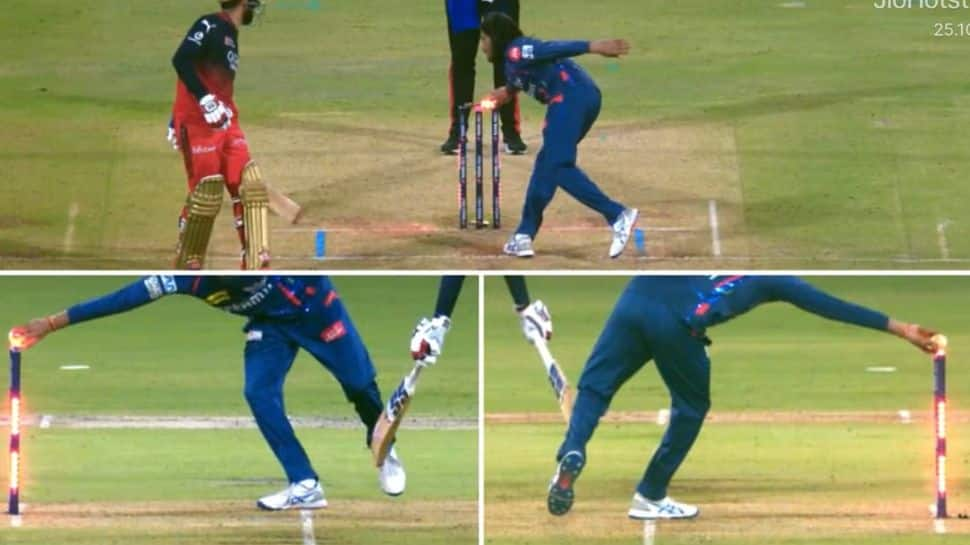In one of the most nail-biting moments of the IPL 2025, the question on every cricket fan’s mind was — Was Jitesh Sharma run-out at the non-striker’s end? Royal Challengers Bengaluru’s (RCB) star wicket-keeper batter narrowly escaped dismissal during a massive chase against Lucknow Super Giants (LSG), and the drama unfolded in a way that left spectators and experts buzzing. Let’s dive deep into what really happened, the crucial laws involved, and why RCB’s Jitesh Sharma remained not out despite the intense run-out attempt.
The Moment of Drama: Jitesh Sharma’s Near Run-Out
It was the 17th over of a high-stakes IPL clash when the tension reached its peak. RCB was chasing a formidable total of 228 runs against LSG, and every wicket was precious. On the final ball of the over, LSG’s Digvesh Rathi made a sharp attempt to run out Jitesh Sharma at the non-striker’s end. Television replays showed that Sharma was indeed outside the crease when Rathi dislodged the bails.
However, what followed was unexpected. Rishabh Pant, LSG’s captain and a seasoned wicket-keeper himself, withdrew the run-out appeal before the third umpire could make a conclusive decision. This act spared Jitesh Sharma from dismissal and kept RCB’s chase alive. The crowd erupted in relief and applause as the tension broke.
Why Jitesh Sharma Would Have Been Not-Out Even Without Pant’s Withdrawal
While Rishabh Pant’s sportsmanship was commendable, cricket laws also favored Jitesh Sharma’s survival on the crease. According to the MCC Laws of Cricket, specifically Law 38.3.1 and its sub-clauses, a non-striker can only be run out if certain conditions regarding the bowler’s action are met.
What the MCC Laws Say
- Law 38.3.1 states that from the moment the ball comes into play until the bowler is expected to release the ball, the non-striker can be run out if out of the crease.
- Law 38.3.1.1 defines the “expected release” as the moment when the bowler’s arm reaches the highest point in the delivery swing.
- Law 38.3.1.2 clarifies that if the bowler has already passed this point, it is no longer legal to attempt a run-out at the non-striker’s end.
In this incident, Digvesh Rathi had completed his bowling action or had stepped outside the popping crease before dislodging the bails. This violated the conditions necessary for a legal non-striker run-out attempt. Hence, even if Rishabh Pant hadn’t withdrawn the appeal, the third umpire would have been bound by the rules to give Jitesh Sharma not out.
Rishabh Pant’s Sportsmanship Deserves Applause
In the heat of a crucial IPL match, where every run and wicket can change the game’s outcome, Pant’s decision to withdraw the appeal showed tremendous sportsmanship and respect for the spirit of cricket. It’s rare to see captains exercise such fairness when the stakes are so high.
Pant’s gesture not only preserved the integrity of the game but also boosted team morale. The hug shared between Pant and Sharma after the withdrawal was a touching moment, epitomizing cricket’s camaraderie beyond fierce competition.
Jitesh Sharma: From Narrow Escape to Match-Winner
This moment of drama turned into a triumphant story for Jitesh Sharma and RCB. Riding on his composure and skill, Sharma anchored the innings brilliantly, steering RCB to victory with 8 balls to spare. His innings was a mix of smart shot selection, steady running between the wickets, and clutch performances under pressure.
The near run-out incident became a pivotal turning point — instead of breaking RCB’s momentum, it galvanized Sharma and his team to push harder, ultimately clinching the match. This performance further cemented Sharma’s status as a key player in RCB’s lineup.

